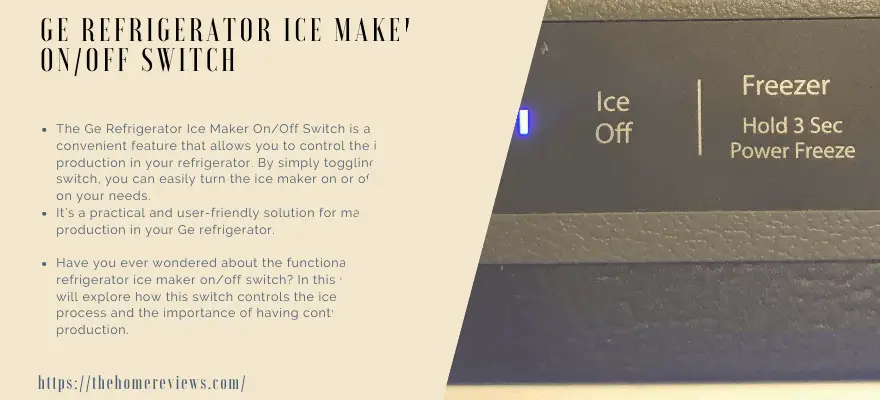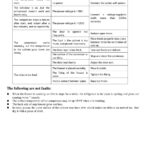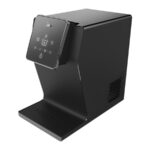
The GE refrigerator ice maker has an on/off switch located either on the ice maker itself or accessed through the refrigerator’s digital display. Simply slide the switch to the right to turn the ice maker off and to the left to turn it on.
This switch functions similarly to a light or power switch, with “ON” at the top and “OFF” at the bottom of the toggle.
Understanding The Ge Refrigerator Ice Maker On/Off Switch
The Ge Refrigerator Ice Maker On/Off Switch is a convenient feature that allows you to control the ice production in your refrigerator. By simply toggling the switch, you can easily turn the ice maker on or off based on your needs. It’s a practical and user-friendly solution for managing ice production in your Ge refrigerator.
Have you ever wondered about the functionality of the Ge refrigerator ice maker on/off switch? In this section, we will explore how this switch controls the ice production process and the importance of having control over ice production.
Exploring The Functionality Of The Ge Refrigerator Ice Maker On/Off Switch
The Ge refrigerator ice maker on/off switch is designed to provide users with convenient control over ice production. Here’s what you need to know:
- When the switch is in the “ON” position, the ice maker is activated and starts producing ice. This allows you to have a steady supply of ice whenever you need it.
- On the other hand, when the switch is turned to the “OFF” position, the ice maker stops producing ice. This can be useful when you don’t need ice for a while or when you want to conserve energy.
- The switch is located in a convenient spot, often on the exterior door of the fresh food compartment. This makes it easy to access and control ice production with just a flip of a switch.
How The Switch Controls The Ice Production Process
Now, let’s dive deeper into how the Ge refrigerator ice maker on/off switch controls the ice production process:
- When the switch is turned on, it activates the ice maker’s components, starting with the water valve that allows water to flow into the ice maker.
- Once the water reaches the ice maker, it fills the ice tray or mold, which is then placed in the freezer compartment to freeze the water into ice cubes.
- The ice maker also consists of a thermostat that monitors the temperature. When the ice cubes are frozen, the thermostat signals the ice maker to release the cubes into the ice bin.
- On the other hand, when the switch is turned off, it interrupts the ice production process. The water valve stops supplying water, and the ice maker ceases to create new ice cubes.
The Importance Of Having Control Over Ice Production
Having control over the ice production process is crucial for several reasons:
- Energy efficiency: By turning off the ice maker when you don’t need ice, you can save energy and lower your utility bills.
- Managing ice supply: Sometimes, you may need a large amount of ice for special occasions or parties. By having control over ice production, you can ensure that you have enough ice readily available.
- Maintenance: Turning off the ice maker when you’re away on vacation or not using the fridge for an extended period can help prevent any issues or malfunctions.
The Ge refrigerator ice maker on/off switch gives you the power to control the ice production process, allowing you to save energy, manage your ice supply, and maintain the functionality of your refrigerator. So next time you’re in need of ice, consider utilizing this convenient feature.
Reasons To Turn Off The Ice Maker
To turn off the ice maker on your GE refrigerator, simply locate the on/off switch, usually found on the ice maker itself or through the refrigerator’s digital display. By toggling the switch to the off position, you can avoid unnecessary ice production and potential ice jams.
Preserving energy and reducing electricity consumption:
- Reduces energy consumption: Turning off the ice maker when not in use can help lower your overall energy consumption, resulting in potential cost savings on your electricity bill.
- Minimizes environmental impact: By conserving energy, you are also contributing to a reduced carbon footprint and helping the environment.
Preventing ice overproduction and avoiding wasted ice:
- Avoids ice overload: Leaving the ice maker continuously on can lead to excess ice production, especially if you do not frequently use ice. This can result in ice overflowing and potentially damaging your refrigerator.
- Minimizes wasted ice: By turning off the ice maker, you can prevent ice from melting and going to waste if it is not being actively used. This ensures that your ice production is in line with your actual needs.
Maintaining the quality and freshness of existing ice:
- Ensures ice quality: When the ice maker is turned off, the existing ice can maintain its quality and freshness for a longer period of time. This is especially important if you have a special event or gathering where you want to serve high-quality ice to your guests.
- Reduces the risk of contamination: By regularly turning off the ice maker, you can minimize the chances of ice becoming contaminated due to prolonged storage or exposure to contaminants in the freezer.
Turning off the ice maker when not in use can have various benefits, including energy conservation, preventing ice overproduction, and maintaining the quality and freshness of existing ice. By following these simple steps, you can optimize the performance of your refrigerator and ensure a more efficient and effective ice-making experience.
How To Turn Off The Ge Refrigerator Ice Maker
To turn off the GE refrigerator ice maker, locate the ON/OFF switch, usually found on the exterior door or through the digital display. Slide the switch to the “off” position, and the ice maker will be deactivated.
Locating the On/Off Switch on Your Ge Refrigerator:
- On most GE refrigerators, the ON/OFF switch for the ice maker is located on the control panel on the exterior door of the fresh food compartment. It is usually labeled “Ice Maker ON/OFF” or might have a picture of an ice cube.
Step-by-Step Guide to Turning Off the Ice Maker:
- Locate the ON/OFF switch for the ice maker on your GE refrigerator’s control panel.
- Make sure the ice maker is currently turned on (the switch should be in the ON position).
- Press the switch or toggle it downward to the OFF position.
- Wait for a few moments to ensure that the ice maker stops producing ice and that the water supply to the ice maker is shut off.
- You can now safely remove the ice bucket or turn off the ice dispenser, as the ice maker is now turned off.
Tips for Troubleshooting Any Issues With The Switch:
- If you are unable to locate the ON/OFF switch for the ice maker on your GE refrigerator, refer to the user manual or contact GE customer support for assistance.
- If the ON/OFF switch appears to be faulty or does not work properly, try the following troubleshooting steps:
- Ensure that the refrigerator is properly plugged into a power source.
- Check that the ice maker is properly connected to the water supply.
- Make sure the water supply valve is fully open.
- Inspect the ice maker for any visible signs of damage or blockages.
- If the troubleshooting steps do not solve the issue, it is recommended to consult a professional technician for further assistance.
Remember, turning off the ice maker on your GE refrigerator is as simple as locating the ON/OFF switch and toggling it to the OFF position. If you experience any difficulties with the switch, follow the troubleshooting tips mentioned above to identify and resolve any issues.
Turning The Ice Maker Back On
Are you wondering how to turn the ice maker back on in your GE refrigerator? Look for the on/off switch located on the ice maker or accessed through the refrigerator’s digital display, and simply slide it to the “on” position to start making ice again.
Understanding When It Is Necessary To Turn The Ice Maker Back On:
- There are several situations when you might need to turn the ice maker back on. Here are a few common scenarios:
- After cleaning or defrosting the freezer: If you have recently cleaned or defrosted your freezer, you will need to remember to turn the ice maker back on before expecting ice production to resume.
- Power outage: If your refrigerator has experienced a power outage, the ice maker may have automatically turned off. In this case, you will need to manually turn it back on once the power is restored.
- Ice maker jam or malfunction: If your ice maker has become jammed or is not producing ice, you may need to turn it off and then back on again to reset it. This can help resolve any temporary issues with the ice maker’s functionality.
Step-by-Step Guide to Turning the Ice Maker Back On:
- Locate the ice maker control switch. The ice maker control switch is typically located on the front or side of the ice maker unit. It may be labeled “on” and “off” or have a power symbol to indicate its function.
- Verify the ice maker is in the off position: Before turning the ice maker back on, make sure the switch is in the off position. This is usually indicated by the switch toggled down or the “Off” label.
- Turn the ice maker on Once you have confirmed that the ice maker switch is in the off position, gently push or toggle the switch to the on position. This is usually indicated by the switch toggled up or the “On” label.
- Wait for ice production to resume: After turning the ice maker back on, it may take a few hours for ice production to resume. Be patient and allow the ice maker time to cycle and freeze the water.
Ensuring Proper Functionality After Reactivation:
- After turning the ice maker back on, you will want to ensure that it is functioning properly. Here are a few steps you can take to ensure proper functionality:
- Check the water supply. Ensure that the water supply to the ice maker is turned on and flowing properly. If there are any issues with the water supply, such as low water pressure or a blocked water line, it may affect the ice maker’s performance.
- Monitor ice production: Keep an eye on the ice maker to see if it begins producing ice after it has been turned back on. If ice production does not resume within a few hours, there may be an underlying issue that requires further troubleshooting or professional assistance.
- Clean the ice maker: Regularly cleaning the ice maker can help prevent blockages and ensure optimal performance. Follow the manufacturer’s instructions for cleaning your specific ice maker model.
Remember, if you are unsure about any steps or encounter persistent issues with your ice maker, it is always best to consult the owner’s manual or reach out to the manufacturer’s customer support for further guidance.
Ge Refrigerator Ice Maker On/Off Switch Troubleshooting
The GE refrigerator ice maker on/off switch troubleshooting involves checking the toggle switch located on the ice maker. Slide it to the ON position at the top to turn the ice maker on, or slide it to the OFF position at the bottom to turn it off.
Common Issues With the Ice Maker On/Off Switch:
- Switch not responding: The ice maker on/off switch may fail to turn on or off, resulting in no ice production or continuous ice production, respectively.
- Loose connection: Sometimes, the switch may have a loose connection, causing intermittent functionality.
- Faulty switch: Over time, the switch itself may become faulty and fail to function properly.
Troubleshooting Steps to Address Switch-Related Problems:
- Check the power supply. Ensure that the refrigerator is properly plugged in and receiving power.
- Inspect the switch. Check if the ice maker on/off switch is in the correct position (ON or OFF) and securely attached.
- Clean the switch. If there is any dirt or debris present, clean the switch carefully using a soft cloth or brush.
- Test the switch: Use a multimeter to check for continuity in the switch when turned on or off.
- Reset the switch: Try resetting the ice maker on/off switch by flipping it on and off a few times.
When to Seek Professional Assistance for Repair or Replacement
- Persistent issues: If the switch continues to malfunction after troubleshooting, it may be time to seek professional repair or replacement.
- The complexity of repair: If the issue seems beyond your capabilities or involves internal wiring, it’s best to leave it to the experts.
- Manufacturer’s warranty: If your refrigerator is still covered by the manufacturer’s warranty, contacting them for assistance is advisable.
Remember, troubleshooting and repair of the ice maker on/off switch should be done with caution. If unsure or uncomfortable with a DIY repair, it is always recommended to consult a professional technician to avoid damaging the appliance further.
Alternative Methods To Control Ice Production
Control ice production in your GE refrigerator with the convenient on/off switch for the ice maker. Easily toggle between on and off to manage ice production. No more excessive ice buildup or wasted energy.
Exploring Other Methods to Control Ice Production Without the On/Off Switch:
- Using manual ice trays or ice cube molds: This traditional method allows you to easily control the ice production in your GE refrigerator without relying on the on/off switch. Simply fill the ice trays or molds with water, put them in the freezer, and wait for the water to freeze. Once frozen, remove the trays or molds and enjoy your manually made ice cubes.
Considerations When Choosing Alternative Ice Production Methods:
- Convenience: Using manual ice trays or molds requires more effort and time compared to the convenience of an on/off switch. Consider whether you are willing to put in the extra time and effort for manual ice production.
- Space: If your freezer has limited space, using manual ice trays or molds may take up valuable real estate. Consider whether you have enough space in your freezer to accommodate the extra trays or molds.
- Quantity: The on/off switch in a GE refrigerator ice maker produces a steady supply of ice. When using manual ice trays or molds, you may not be able to produce as much ice as quickly. Consider how much ice you typically use and whether manual production will meet your needs.
- Freshness: The on/off switch allows you to always have fresh ice on hand. With manual ice trays or molds, you will need to regularly empty the trays or molds and refill them to ensure a constant supply of fresh ice.
- Versatility: Manual ice production allows you to customize the shape and size of your ice cubes. If you prefer specific shapes or sizes for your ice, using manual trays or molds gives you more control in this aspect.
- Energy efficiency: By manually controlling the ice production, you can potentially save energy by reducing the overall usage of the ice maker in your GE refrigerator. This can be advantageous for those who are conscious of their energy consumption.
While the on/off switch in a GE refrigerator ice maker provides a convenient way to control ice production, there are alternative methods available. Using manual ice trays or molds gives you more control over the process but requires additional time and effort.
Consider the factors mentioned above to determine which method suits your needs best.
Frequently Asked Questions
Can I turn off the ice maker in my Ge refrigerator?
Yes, you can easily turn off the ice maker in your GE refrigerator.
How Do I Turn Off the Ice Maker in My Ge Refrigerator?
To turn off the ice maker in your GE refrigerator, simply slide the switch to the off position.
Why would I want to turn off the ice maker in my refrigerator?
Turning off the ice maker can be beneficial if you don’t need ice or if you want to save energy.
How Do I Turn the Ice Maker Back On in My Ge Refrigerator?
To turn the ice maker back on, simply slide the switch to the ON position.
Where Can I Find the On/Off Switch for the Ice Maker in My Ge Refrigerator?
Depending on the model, the on/off switch may be located directly on the ice maker or accessed through the refrigerator’s digital display.
Conclusion
The Ge refrigerator ice maker on/off switch is a crucial component for controlling the production of ice in your appliance. By understanding how to use this switch effectively, you can easily turn the ice maker on or off whenever necessary.
One important thing to note is that the location of the on/off switch may vary depending on your refrigerator model. It could either be located on the ice maker itself or accessed through the refrigerator’s digital display. Regardless of its location, the process remains simple and straightforward.
To turn off the ice maker, slide the switch to the right or flip it to the “off” position. This prevents further ice production. Conversely, sliding the switch to the left or flipping it to the “on” position will activate the ice maker again, allowing it to start producing ice.
By utilizing the Ge refrigerator ice maker on/off switch correctly, you can optimize its functionality and ensure a continuous supply of ice that meets your needs. Don’t forget to consult your appliance’s manual for specific instructions tailored to your model.




